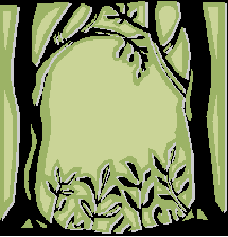



|
TAGB was estimated by measuring
all organic materials above mineral soil. TAGB was divided into "tree"
(broad-leaved trees) and "non-tree" (other components, predominantly
palms) components based on structural and ecological significance and
practicality of measurement.
Tree diameter was measured at 1.37 m above the ground (dbh) or immediately above the tree buttress or stilt roots when present. Trees were separated into seven diameter classes based on dbh (<10, 10¯30, 30¯50, 50¯70, 70¯100, 100¯200 and >200 cm dbh). Palms were sampled separately from broadleaf trees. Kauffman and Kauffman them into three categories (basal palms with no trunks, <10 and 10 cm dbh). Vines and lianas were placed in two size classes (<10 and 10 cm dbh). Other components included small dicots (plants <1.37 m in height), litter/rootmat (forest floor), standing dead trees and palms, and dead and downed coarse woody debris (CWD). |

1. |
Individual equations for each forest component were used for calculating the biomass (Table 2 and Table 3). Biomass of trees 5 cm dbh was calculated from equations based on dbh given by Higuchi et al. (1998) for Amazonian trees. Biomass of trees <5 cm dbh was calculated from equations based on dbh given by Hughes et al. (1999). Tree height was estimated from a regression equation with tree diameter as the independent variable. Data for the tree height model were collected from 129 trees in Rondônia. Diameter at breast height of the trees ranged from 1.5 to 238 cm.
Steps involved with the methodology
Biomass of CWD was calculated by using the methods of Van Wagner (1968). Transects to measure mass of CWD 7.6 cm in diameter were 15 m long. Pieces of CWD that were 2.5¯7.6 cm in diameter were measured along the central 5 m of the 15-m transect. Coarse woody debris was further separated into tree (dicot) wood or palm wood components. The 7.6-cm diameter class was also separated into sound or rotten classes following the methods of Kauffman et al. (1988) and Brown (1971).
One hundred samples for each size class of CWD were collected in forests near Jamari, Rondônia, to obtain an average wood density (sg=0.41 g cm-3 for CWD 2.5¯7.6 cm, 0.49 g cm-3 for sound wood, 0.34 g cm-3 for rotten wood, and 0.33 g cm-3 for palm wood 7.6 cm diameter). For the 2.5¯7.6 cm diameter classes, the diameter and angle off the horizontal of 65 individual pieces along a 100 m transect were measured to calculate the quadratic mean diameter and wood particle tilt (Brown and Roussopoulos, 1974). Thereafter, they only counted pieces that intersected the line, and they used density, quadratic mean diameter, and wood particle tilt variables to calculate biomass.
To calculate forest floor biomass, each sample was initially weighed in the field. Sub-samples were then oven-dried to determine the ratio of wet-to-dry weight. This ratio was then applied to the entire sample to convert from wet-to-dry weight.
To estimate biomass of basal leaf palms, the number of leaves of each individual palm encountered in the 2 m×10 m plot was counted and multiplied by a mean weight per leaf derived from a random sample of 30 basal leaves that had been oven-dried and weighed. Three equations were necessary to ascertain biomass of palms: biomass of Attlea sp. 1.78 m high was calculated with the model developed by Anderson (1983); biomass of other palm species 10 cm dbh was estimated with the model of Frangi and Lugo (1985); and biomass of palms <10 cm dbh was calculated by using a model developed specifically for this study.
Vine biomass estimates were calculated with the model given by Putz (1983). All seedlings (<1.37 m height) were counted in each of the 16 (1 m×1 m) plots per site. Seedling biomass was based on sub-sample of 50 randomly collected oven-dried seedlings from which an average weight per seedling had been determined.
References:
Brown, J.K., 1974. Handbook for Inventorying Downed Woody Material. USDA
Forest Service, Ogden, UT, 25 pp.
Brown, S., 1997. Estimating Biomass and Biomass Change of Tropical Forests:
A Primer. Forestry Paper 134, FAO, Rome.
Brown, S. and Lugo, A.E., 1984. Biomass of tropical forests: a new estimate
based on forest volumes. Science 223, pp. 1290¯1293. Abstract-GEOBASE
Brown, S., Lugo, A.E., 1990. Biomass estimates for Brazil's Amazonian moist
forests. In: Forest'90: Annals of the First International Symposium on Environmental
Studies on Tropical Rain Forests, Manaus, Brazil, pp.46¯52.
Brown, S. and Lugo, A.E., 1992. Aboveground biomass estimates for tropical
moist forests of the Brazilian Amazon. Interciencia 17, pp. 8¯18.
Brown, S., Lugo, A.E. and Iverson, L.R., 1992. Processes and lands for
sequestering carbon in the tropical forest landscape. Water Air Soil Pollut.
64, pp.139¯155. Abstract-Compendex | Abstract-GEOBASE | Abstract-EMBASE
Brown, I.F., Nepstad, D.C., Pires, O., Luz, L.M. and Alechandre, A.S.,
1992. Carbon storage and land-use in extractive reserves, Acre, Brazil.
Environ. Conserv. 19, pp. 307¯315. Abstract-GEOBASE
Brown, I.F., Martinelli, L.A., Thomas, W.W., Moreira, M.Z., Ferreira, C.A.
and Victoria, R.A., 1995. Uncertainty in the biomass of Amazonian forests:
an example from Rondônia, Brazil. Forest Ecol. Mgmt. 75, pp. 175¯189. Abstract
| PDF (1041 K)
Kauffman, J.B., Sanford, R.L., Cummings, D.L., Salcedo, I.H. and Sampaio,
E.V.S.B., 1994. Biomass and nutrient dynamics associated with slash fires
in neotropical dry forests. Ecology 74, pp. 140¯151.
Kauffman, J.B., Cummings, D.L., Ward, D.E. and Babbit, R., 1995. Fire in
the Brazilian Amazon. I. Biomass, nutrient pools, and losses in slashed
primary forests. Oecologia 104, pp. 397¯408. Abstract-Elsevier BIOBASE |
Abstract-GEOBASE
Pictures:
1. Picture from: http://www.perudiscover.com/TOURS/amazon_intro_side.htm
|
Home
|
Index
|
Preservation
|
|
Goals
|
Characterization |
Time plan |
|
FAQ's |
Monitoring |
Members |
|
Presentation |
Minutes |
Introduction
|